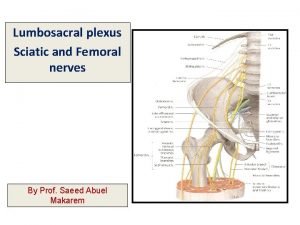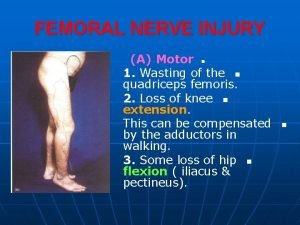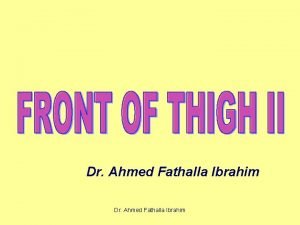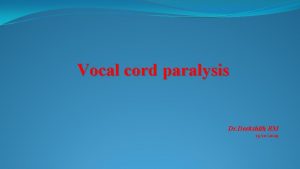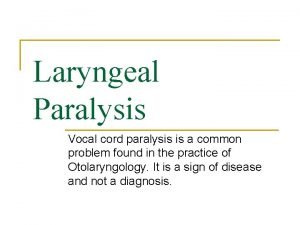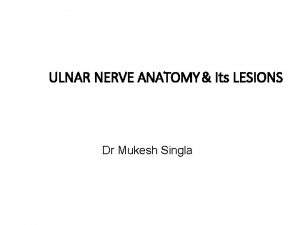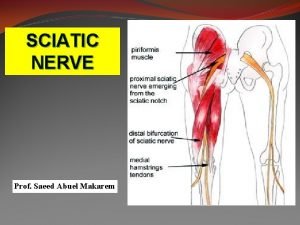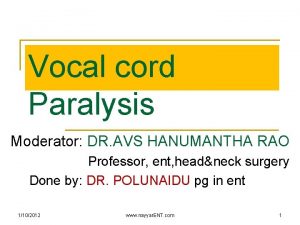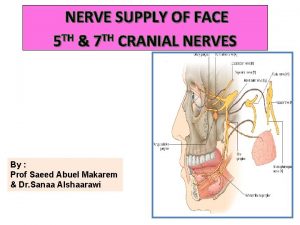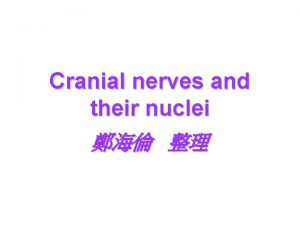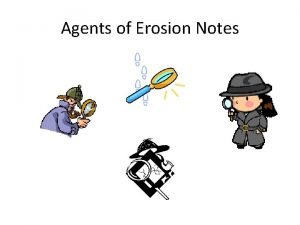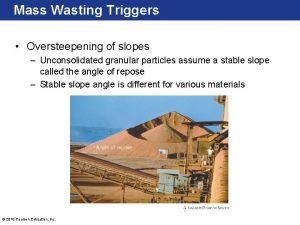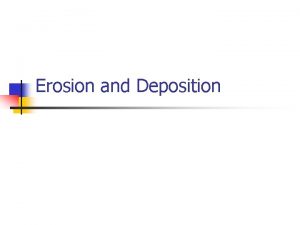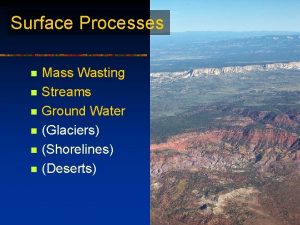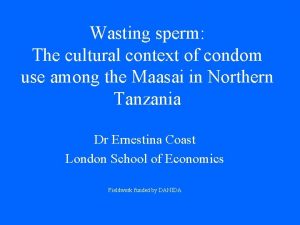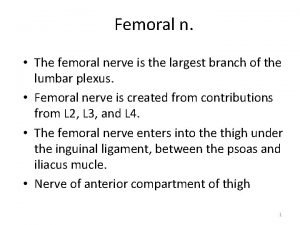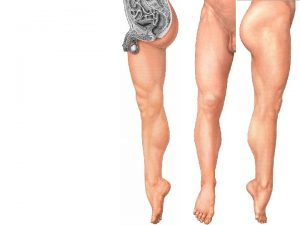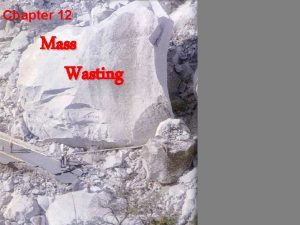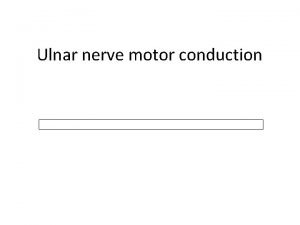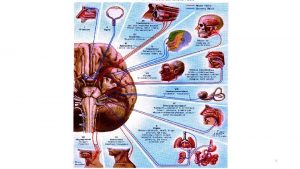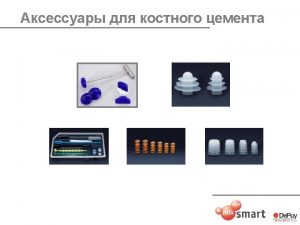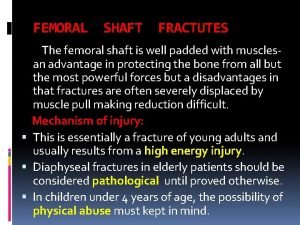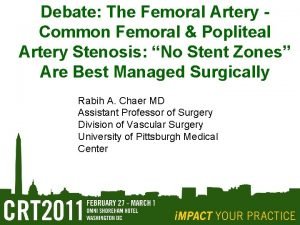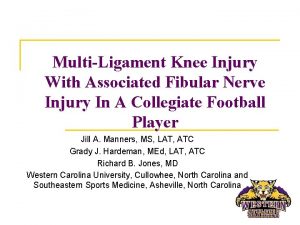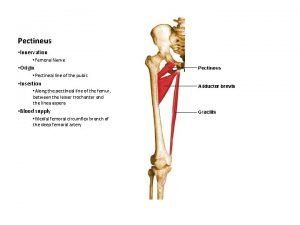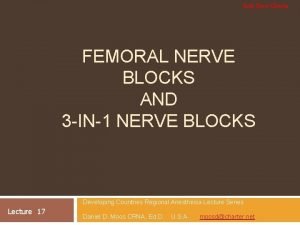FEMORAL NERVE INJURY A Motor n 1 Wasting






















- Slides: 22

FEMORAL NERVE INJURY (A) Motor n 1. Wasting of the n quadriceps femoris. 2. Loss of knee n extension. This can be compensated by the adductors in walking. 3. Some loss of hip n flexion ( iliacus & pectineus). n

FEMORAL NERVE INJURY (B) Sensory Loss Over: 1. The front and n medial side of the thigh (anterior and medial cutaneous nerves of the thigh). n

FEMORAL NERVE 2. The medial side n of the lower part of the leg. 3. The medial n border of the foot as far as the ball of the big toe (Saphenous nerve).

OBTURATOR NERVE INJURY Causes : n Pressure of the fetal n head during labour. Pelvic wall malignancy. Motor : n Incomplete loss of n adduction ( ischial part of adductor magnus is functioning). n

OBTURATOR NERVE INJURY Sensory loss : n Minimal over the n middle of the medial thigh.

SCIATIC NERVE INJURY Causes : n 1. Badly placed intramuscular injection. n

SCIATIC NERVE INJURY 2. Posterior n dislocation of the hip joint. 3. Fracture of the pelvis. n

SCIATIC NERVE INJURY Motor : n 1. Marked wasting of the muscles below the knee. 2. Weak flexion of the n knee ( sartorius & gracilis are functioning). 3. The foot assumes the n position of foot drop (planter flexed position) by its weight. n

SCIATIC NERVE INJURY Sensory loss : n Below the knee. n EXCEPT : n The area supplied n by the Saphenous nerve. Trophic ulcers in n the sole.

SCIATICA It is pain in the leg n extending from the buttock towards the heel. Causes : n Pressure on the sciatic n nerve or its roots by prolapsed intervertebral disc (L 4 -5) or cancer deposits adjacent to the nerve.

SCIATICA Diagnosis : n 1. Straight leg raising n is diminished by the pain of sciatica. 2. Sensory loss over n the lateral side of the leg. 3. Loss of ankle n reflex.

COMMON PRONEAL NERVE INJURY It is the most liable n nerve to be injured in the lower limb. Because of its superficial position. The nerve may be n severed during fracture of the neck of fibula or when the knee joint is injured or dislocated.

COMMON PRONEAL NERVE INJURY Motor n Loss of: n 1. Dorsiflexion n (extensor muscles) 2. Eversion ( peronei). The foot – drops. n And becomes n inverted.

COMMON PRONEAL NERVE INJURY The toes drag on the floor in walking. The patient has to n raise his foot high to keep the toes from hitting the ground. The foot comes down suddenly. n n

COMMON PRONEAL NERVE INJURY Sensory loss n over: 1. Lateral and n anterior sides of the leg. 2. Dorsum of the foot and toes. 3. Medial side of the big toe. n n

DEEP PERONEAL NERVE INJURY Motor : n Loss of dorsiflexion of the foot and toes. The foot becomes planter flexed and inverted because of the unopposed action of Tibialis posterior. An attitude referred to as Equinovarus. n n

DEEP PERONEAL NERVE INJURY Sensory Loss : Between the first and second toes. n n

SUPERFICIAL PERONEAL NERVE INJURY Motor : n Evertion by the n peroni is lost. The foot becomes n inverted.

SUPERFICIAL PERONEAL NERVE INJURY Sensory Loss : n 1. Lateral side of n the leg. 2. Dorsum of the n foot and toes. 3. Medial side of n the big toe.

TIBIAL NERVE INJURY Motor : n All the muscles in the back of the leg and sole of the foot are paralysed. The foot is n dorsiflexed and everted. An attitude referred to as Calcaneovalgus. n n

TIBIAL NERVE INJURY Sensory loss over : 1. Lateral side of n the leg and foot. 2. Trophic ulcers in the sole. n n

THANK YOU BEST WISHES
 Superficial peroneal nerve entrapment
Superficial peroneal nerve entrapment Femoral nerve injury
Femoral nerve injury Femoral canal structures
Femoral canal structures Termination of femoral artery
Termination of femoral artery Intentional injury and unintentional injury
Intentional injury and unintentional injury Lateral cutaneous nerve of thigh
Lateral cutaneous nerve of thigh Positions of vocal cords
Positions of vocal cords Vocal cord positions
Vocal cord positions Quadrangular membrane larynx
Quadrangular membrane larynx Claw hand
Claw hand Peroneal nerve palsy
Peroneal nerve palsy Unilateral superior laryngeal nerve injury
Unilateral superior laryngeal nerve injury Facial nerve injury
Facial nerve injury Trigeminal nerve which cranial nerve
Trigeminal nerve which cranial nerve Biological weathering
Biological weathering Mass wasting occurs when____.
Mass wasting occurs when____. Geology
Geology Mass wasting
Mass wasting Mass wasting processes
Mass wasting processes Wasting sperm
Wasting sperm Mass wasting
Mass wasting Mass wasting definition
Mass wasting definition Bitemporal wasting in copd
Bitemporal wasting in copd
